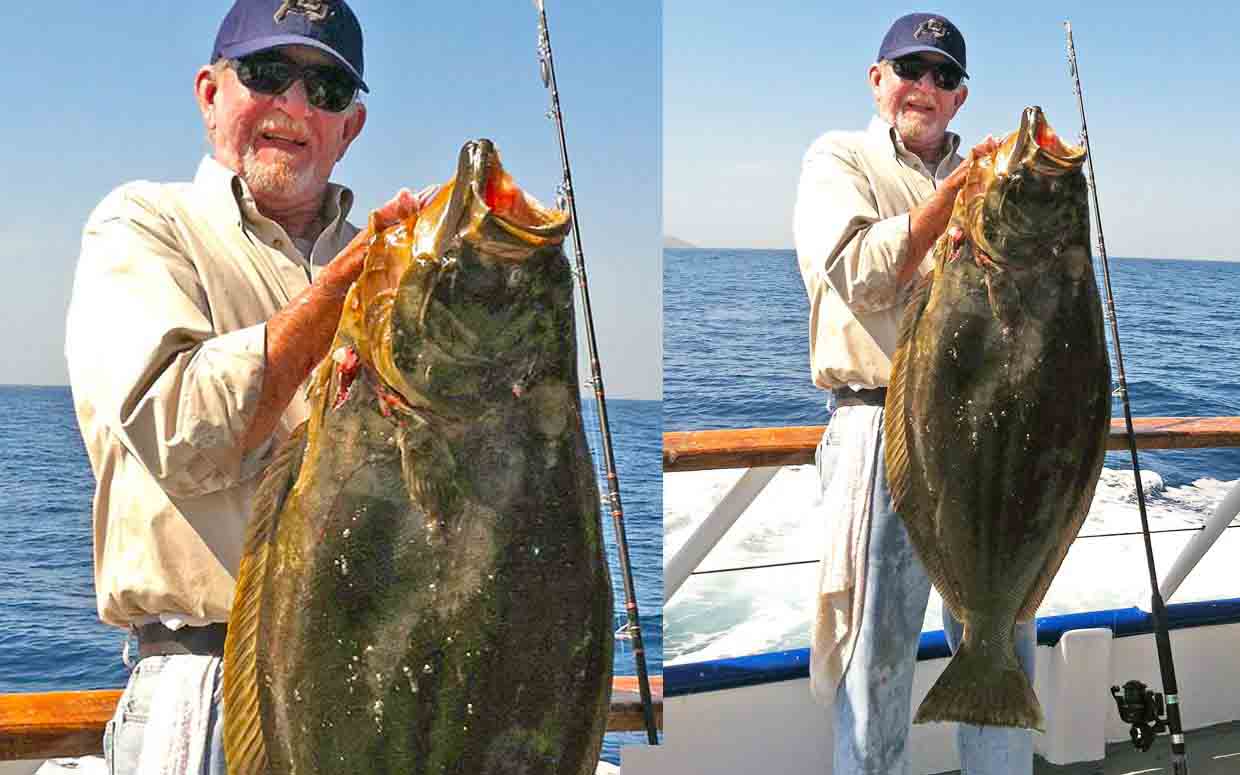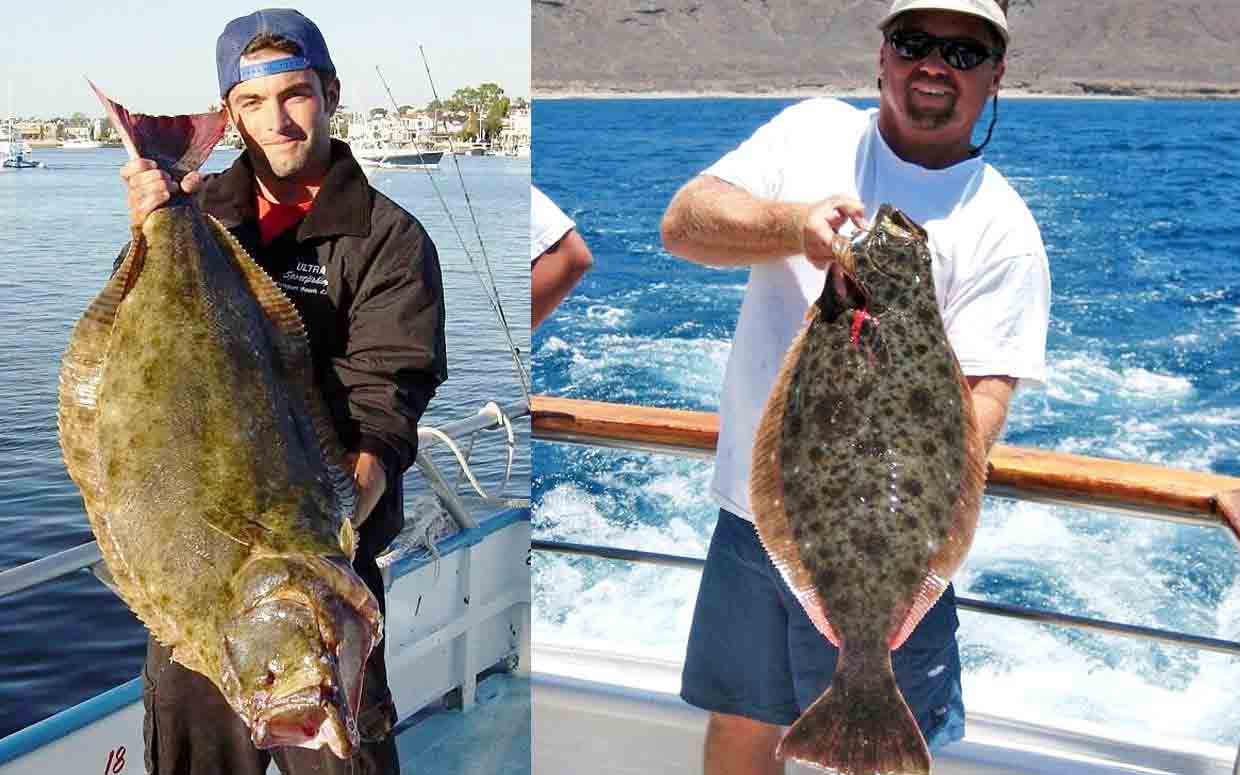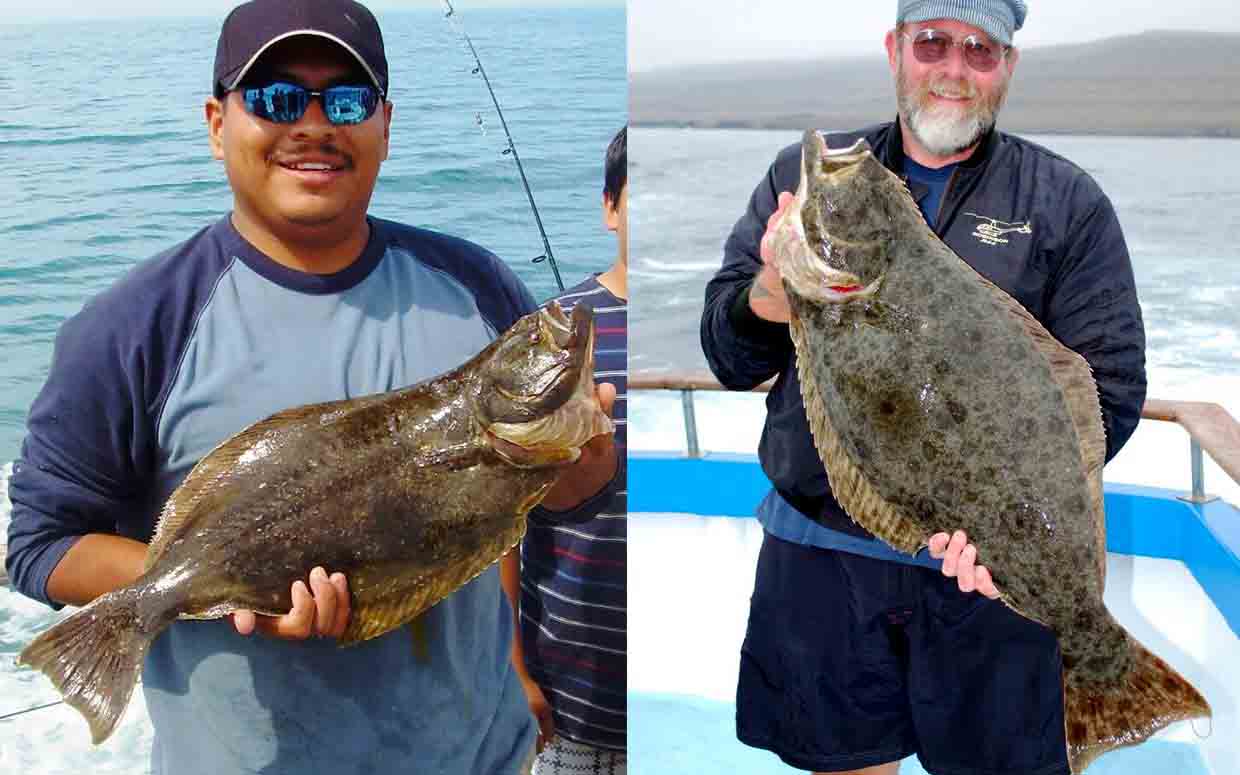Halibut Fishing
Yellowtail Fishing in Southern California - Techniques & Seasons

Halibut fishing has very specific techniques that vary quite a bite from most other game fish techniques here in southern California. To start halibut for the most part stay relatively close to the bottom. This is not always the case, but catching halibut in the mid and upper part of the water column is typically an accidental catch while targeting other game fish. Knowing that halibut typically spend much of the time on the bottom will narrow the techniques down to those that keep your bait close or on the bottom. Halibut are a year round game fish with spring and summer being the best seasons for catching quantity catches with quality sized catches in the winter and early spring.
One technique used during the spring months while typically fishing for halibut is to take a few minutes to explore the areas around the boat. Testing this area out could lead to boating a trophy halibut. Live squid and fin bait both work well on halibut and a very active bait when fishing fin bait or squid is ideal. While most anglers are soaking their squid waiting for the halibut to come through you can pin on your bait and with a 2 to 3 oz torpedo sinker cast out away from the boat letting your offering sink to the bottom. Once hitting the bottom your line will stop at which point you reel in the excess until you are in contact with your bait.
Leave the bait there for maybe 30 seconds and then if no bites gently sweep your rod sideways moving your bait and then stop it again. Continue this process until under the boat at which point you reel in and cast in a slightly different direction. After a dozen casts or more you can cover a good amount of area and explore if a halibut is close by. Often halibut will bite as you lift the rod and your instincts are to set the hook, but let the line back and let the halibut take the bait waiting until the line goes tight to set the hook. Once the halibut is hooked do not yank up or pump your rod as this will greatly increase the likelihood of losing your fish by either pulling the hook or breaking it off on its teeth. Instead lift up in a controlled and steady manner and then wind and then lower your rod and repeat slowly raising the fish off the bottom. Often halibut will come up fairly easily right up to the surface and applying this gentle tension can greatly reduce the likelihood of having the hook pull or other problems. Once the halibut is close to the surface do not if at all possible lift it out of the water. Typically if they touch the surface they will come to life and make a hard and powerful run back to the bottom often resulting in a lost fish. Instead keep the halibut just beneath the surface and call for a gaff. With a good gaff, the halibut will be securely aboard the ship before it realizes what had happened. If your halibut has been spooked, let it run, even loosing the drag a little if your drag is real tight. This gives the line extra insurance if stressed. Once the halibut has stopped running start the slow raising and winding technique until back to the boat. Once your halibut is gaffed and as it is being lifted into the boat make sure to stay pretty far away from it as they will at times go wild slamming into things and pose some danger. Also as the halibut is being lifted into the boat put your reel into free spool so if for some reason the halibut shakes off the gaff your line will not snap and you can fight the halibut back to the boat.
Another technique for catching halibut is dropping down while others are fishing barracuda. The key with this technique is to know how deep the water that you are in is. If over 120 feet your odds for halibut diminish quite a bit. From 40-80 feet and your in prime halibut habitat. Similar to fishing white sea bass getting your bait under the barracuda is key and right on the bottom usually the most effective. A 4 oz torpedo sinker will get you past most of the barracuda and into the halibut zone. Again slowly dragging your bait back to the boat covers the greatest area and since you are often drifting you will be moving without needing to reel in. If the drift is pretty strong use more weight as being in contact with the bottom is key and change your bait every few minutes. Halibut will group in large numbers in areas where barracuda are injuring bait fish waiting for an easy meal. While fishing for halibut this way, you may also catch a surprise white sea bass or a deep running barracuda. If the barracuda are in too great of numbers using larger bait such as a mackerel may keep them away just make sure to increase your hook size accordingly.
Another technique is dragging the front edge of a reef. The front edge of a reef is determined by the current and which every edge of the reef the current touches first is considered the front edge. Often while fishing a reef for calico bass, barracuda, sand bass etc prime halibut habitat located near by. Halibut like to hang out in the transition zone between sandy bottom and reef.
Another technique for catching halibut is dropping down while others are fishing barracuda. The key with this technique is to know how deep the water that you are in is. If over 120 feet your odds for halibut diminish quite a bit. From 40-80 feet and your in prime halibut habitat. Similar to fishing white sea bass getting your bait under the barracuda is key and right on the bottom usually the most effective. A 4 oz torpedo sinker will get you past most of the barracuda and into the halibut zone. Again slowly dragging your bait back to the boat covers the greatest area and since you are often drifting you will be moving without needing to reel in. If the drift is pretty strong use more weight as being in contact with the bottom is key and change your bait every few minutes. Halibut will group in large numbers in areas where barracuda are injuring bait fish waiting for an easy meal. While fishing for halibut this way, you may also catch a surprise white sea bass or a deep running barracuda. If the barracuda are in too great of numbers using larger bait such as a mackerel may keep them away just make sure to increase your hook size accordingly.
Another technique is dragging the front edge of a reef. The front edge of a reef is determined by the current and which every edge of the reef the current touches first is considered the front edge. Often while fishing a reef for calico bass, barracuda, sand bass etc prime halibut habitat located near by. Halibut like to hang out in the transition zone between sandy bottom and reef.
So while other anglers are fishing on the reef going to the front of the boat and casting along the imaginary edge of the reef and the sand or hard bottom and then slowly dragging back to the boat may land you a trophy halibut. Keep track of the reef and if you feel too many rocks or get hung up in the rocks move farther up or cast above the boat more. The crew or captain can give you a rough idea on where to start. You can cover a large area of prime halibut water this way. Still having tried the entire transition zone with no luck you can get back to fishing the reef for a bit. Maybe after 45 minutes if the boat hasn’t moved try dragging the transition zone again. Often halibut will move from neighboring areas attracted by chumming of the boat. This technique works on all length trips and maybe one of the most effective for consistently catching large halibut.
Other suggestions to improve hooking & landing halibut
Here are some other suggestions for fishing and landing halibut. When fishing halibut having your drag set fairly light is important as a tight drag set will often pull the hook are put too much stress on the line. Sometimes light line results in many more bites. Unlike other game fish a 40 pound halibut can be landed on 10 pound test if you have the patience in fighting the fish. Using light line especially with anchovy or sardine baits will sometimes fool reluctant halibut into taking your bait.
Artificials can also be used to take halibut with popular lures such as fish traps and other plastic bait fish imitations. The key when fishing plastics is to stay in contact with the bottom reeling back some then letting it drop then reeling again. You can play with the pace until a pattern develops. Plastics work well when fin baits are limited or when wanting to cover a lot of area in a hurry. Favorite colors for fish imitations include sardine and anchovy coloring which makes sense. Match a lead head to the weight least needed to stay in contact with the bottom. The lighter the weight typically the more natural the presentation and more bites.
With these techniques and a little patience a trophy halibut is always a reality.










